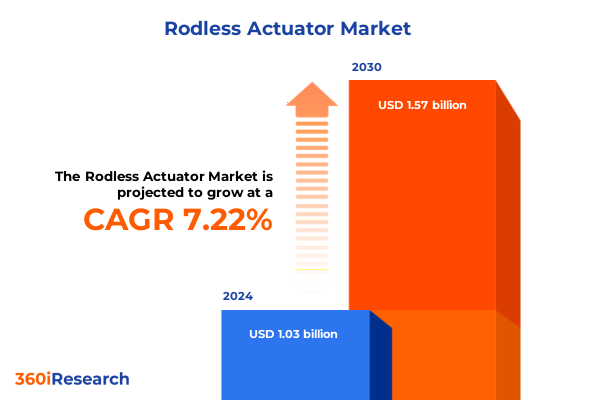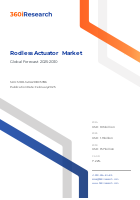The Rodless Actuator Market size was estimated at USD 1.03 billion in 2024 and expected to reach USD 1.11 billion in 2025, at a CAGR 7.22% to reach USD 1.57 billion by 2030.

Introduction: The Evolution and Role of Rodless Actuators
Rodless actuators have emerged as pivotal components in modern automation, offering streamlined motion control without the limitations of traditional piston rods. By delivering linear movement through guided sliding carriages, these devices minimize installation footprints and reduce maintenance complexities. Their adaptability across diverse sectors-from precision equipment in medical devices to heavy machinery in construction-underscores their critical role in driving operational efficiency. This executive summary traces the evolution of rodless actuators, highlights recent technological and regulatory shifts, and distills actionable insights for decision-makers seeking to harness their transformative potential.
Transformative Shifts in the Rodless Actuator Landscape
Over the past decade, the rodless actuator market has undergone profound changes driven by digitalization and the rising demand for sustainable automation. Industry 4.0 initiatives have spurred integration of smart sensors and predictive maintenance, enabling real-time performance monitoring and minimizing downtime. Concurrently, electrification trends have shifted preferences toward electric rodless actuators, valued for their precision, energy efficiency, and cleaner operation compared to hydraulic or pneumatic alternatives. Advancements in materials and design have enhanced belt-driven systems and linear motors, yielding higher acceleration rates and motor synchronization. Regulatory emphasis on reducing carbon footprints has further accelerated adoption of greener mechanisms and encouraged manufacturers to prioritize resource-efficient production. Through these transformative shifts, the market is moving beyond conventional motion solutions and embracing interconnected, intelligent actuators that respond to evolving industrial demands.
Assessing the Cumulative Impact of US Tariffs in 2025
In 2025, newly imposed tariffs on certain imported components have reshaped supply-chain dynamics for rodless actuators. Levies on steel, aluminum, and specific electromechanical assemblies have elevated production costs for domestic and foreign suppliers alike. As a result, manufacturers have pursued alternative sourcing strategies, diversifying procurement across multiple regions to mitigate price volatility. Some producers have explored nearshoring options, relocating subassembly lines closer to key markets to reduce lead times and tariff burdens. Meanwhile, cost pass-through to end-users has spurred design optimizations that prioritize material efficiency and modular architectures. Collaborative agreements with local distributors are increasingly common, enabling shared risk and streamlined logistics. By adopting these adaptive measures, industry players are cushioning the impact of trade policies while preserving competitiveness and ensuring continuity of supply.
Key Insights from Market Segmentation
The market’s product type segmentation reveals diverging dynamics across electric rodless actuators, which command attention for their programmability and emission-free operation; hydraulic rodless actuators, prized in heavy-load environments for robust force output; and pneumatic rodless actuators, still favored where simplicity and low upfront costs matter most. When considering actuation mechanisms, ball screw configurations deliver high precision and stiffness, belt-driven systems offer rapid travel at lower noise, linear motor designs excel in high-speed positioning, and rack & pinion arrangements balance load capacity with installation flexibility. Distribution channels bifurcate between offline sales-driven by established relationships with industrial suppliers-and online platforms that provide rapid access to standardized components. End-use segmentation spans critical sectors: aerospace applications including aircraft manufacturing & assembly, in-flight control systems, landing gear systems, and satellite & spacecraft assembly; automotive uses such as automated assembly lines, robotic assembly cells, and seat adjustment mechanisms; construction implementations in automated construction systems, heavy machinery and equipment, and material handling; as well as food & beverage, manufacturing, medical, mining, oil & gas, and packaging, each demanding specific performance attributes and compliance certifications.
This comprehensive research report categorizes the Rodless Actuator market into clearly defined segments, providing a detailed analysis of emerging trends and precise revenue forecasts to support strategic decision-making.
- Product Type
- Actuation Mechanism
- Distribution Channel
- End-use
Strategic Perspectives across Global Regions
Regional profiles illustrate distinct growth drivers and challenges. In the Americas, demand is buoyed by reshoring trends and investments in additive manufacturing, prompting suppliers to tailor solutions for tooling and robotics applications. Europe, the Middle East & Africa present a mosaic of mature markets emphasizing energy-efficient automation and emerging economies investing in infrastructure projects, driving interest in rugged actuator designs. Asia-Pacific remains the most dynamic region, with expanding electronics manufacturing in Southeast Asia, heavy industry in China’s interior provinces, and government-led smart factory initiatives in Japan and South Korea; this diverse landscape fuels demand for both standardized and highly customized rodless actuators.
This comprehensive research report examines key regions that drive the evolution of the Rodless Actuator market, offering deep insights into regional trends, growth factors, and industry developments that are influencing market performance.
- Americas
- Asia-Pacific
- Europe, Middle East & Africa
Competitive Landscape: Leading Companies Shaping the Market
The competitive arena features global leaders and specialized niche players innovating across the value chain. Airtac International Group and AIRTEC Pneumatic GmbH excel in compact, cost-effective pneumatic solutions. Bosch Rexroth AG and Festo AG & Co. KG leverage strong R&D capabilities to advance modular electric and servo-driven systems. Camozzi Automation S.p.A. and CKD Corporation focus on integrated actuator networks for seamless factory automation. HAWE Hydraulik SE and Howa Machinery, Ltd. deliver high-pressure hydraulic variants for heavy-duty applications. KOGANEI International America, Inc. and Konan Electric Co., Ltd. offer bespoke actuation modules. Linak A/S continues to push electro-mechanical actuator boundaries. Metal Work Pneumatic Australia Pty Limited and Metal Work S.p.A. bring local market agility. Mindman Industrial Co., Ltd. and Norgren Ltd. by IMI PLC emphasize rapid delivery and technical support. MTS Systems Corporation, Parker Hannifin Corporation, and SKF Group supply advanced materials and motion control platforms. SMC Corporation, THK Co., Ltd., THOMSON Industries, Inc., Tolomatic, Inc., and UNIVER S.p.A. each maintain broad portfolios addressing diverse industry needs.
This comprehensive research report delivers an in-depth overview of the principal market players in the Rodless Actuator market, evaluating their market share, strategic initiatives, and competitive positioning to illuminate the factors shaping the competitive landscape.
- Airtac International Group
- AIRTEC Pneumatic GmbH
- Bosch Rexroth AG
- Camozzi Automation S.p.A.
- CKD Corporation
- Festo AG & Co. KG
- HAWE Hydraulik SE
- Howa Machinery, Ltd.
- KOGANEI International America, Inc.
- Konan Electric Co., Ltd.
- Linak A/S
- Metal Work Pneumatic Australia Pty Limited
- Metal Work S.p.A.
- Mindman Industrial Co., Ltd.
- MTS Systems Corporation
- Norgren Ltd. by IMI PLC
- Parker Hannifin Corporation
- SKF Group
- SMC Corporation
- THK Co., Ltd.
- THOMSON Industries, Inc.
- Tolomatic, Inc.
- UNIVER S.p.A.
Actionable Recommendations for Industry Leaders
Drive strategic partnerships with component suppliers to co-develop next-generation electric and smart actuators, reducing time-to-market and sharing R&D costs. Invest in modular architectures to enable rapid customization for end-use sectors, improving responsiveness to shifting application requirements. Strengthen digital capabilities by embedding IoT sensors and cloud-based monitoring platforms, turning data into predictive maintenance insights that optimize uptime. Diversify sourcing networks and explore nearshoring opportunities to alleviate tariff pressures and enhance supply-chain resilience. Align product roadmaps with sustainability targets, adopting eco-friendly materials and low-energy operation modes to meet evolving environmental regulations. Foster cross-industry collaboration, leveraging learnings from automotive, aerospace, and consumer electronics to accelerate innovation cycles. Prioritize customer education and technical training programs, ensuring seamless adoption of advanced actuator technologies and maximizing lifecycle value.
Explore AI-driven insights for the Rodless Actuator market with ResearchAI on our online platform, providing deeper, data-backed market analysis.
Ask ResearchAI anything
World's First Innovative Al for Market Research
Conclusion: Navigating the Future of Rodless Actuator Markets
Rodless actuators stand at the intersection of efficiency, precision, and adaptability-qualities that are paramount in today’s automated environments. By understanding the nuanced impacts of trade policies, segmentation dynamics, regional drivers, and competitive activities, decision-makers can craft strategies that balance innovation with operational resilience. The convergence of digital transformation and sustainability imperatives will continue to shape product development and market positioning. Organizations that embrace open collaboration, invest in smart actuation platforms, and remain agile in their sourcing and distribution strategies are best positioned to capture emerging opportunities and sustain long-term growth.
This section provides a structured overview of the report, outlining key chapters and topics covered for easy reference in our Rodless Actuator market comprehensive research report.
- Preface
- Research Methodology
- Executive Summary
- Market Overview
- Market Dynamics
- Market Insights
- Cumulative Impact of United States Tariffs 2025
- Rodless Actuator Market, by Product Type
- Rodless Actuator Market, by Actuation Mechanism
- Rodless Actuator Market, by Distribution Channel
- Rodless Actuator Market, by End-use
- Americas Rodless Actuator Market
- Asia-Pacific Rodless Actuator Market
- Europe, Middle East & Africa Rodless Actuator Market
- Competitive Landscape
- ResearchAI
- ResearchStatistics
- ResearchContacts
- ResearchArticles
- Appendix
- List of Figures [Total: 24]
- List of Tables [Total: 333 ]
Take the Next Step: Connect with Ketan Rohom for the Full Report
To gain an in-depth understanding of these trends, competitive benchmarks, and strategic action plans, connect with Ketan Rohom, Associate Director, Sales & Marketing, to secure the comprehensive market research report and stay ahead in the evolving world of rodless actuators.

- How big is the Rodless Actuator Market?
- What is the Rodless Actuator Market growth?
- When do I get the report?
- In what format does this report get delivered to me?
- How long has 360iResearch been around?
- What if I have a question about your reports?
- Can I share this report with my team?
- Can I use your research in my presentation?




